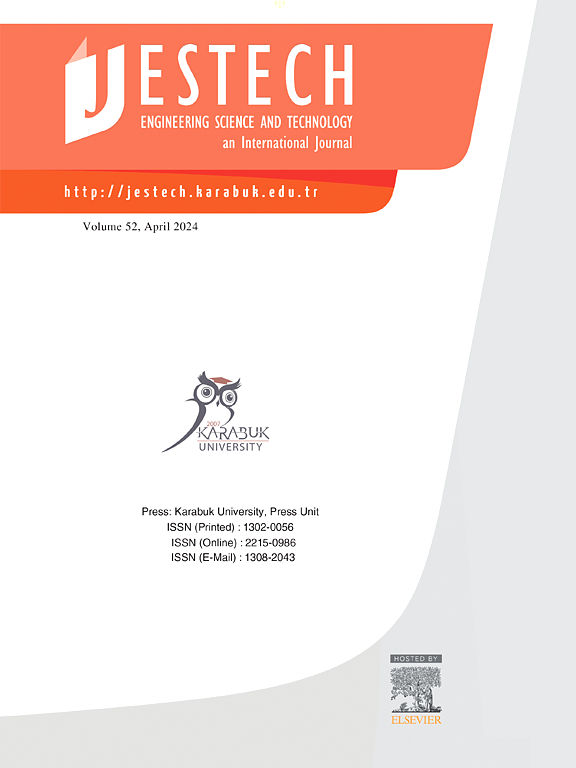Artificial intelligence analysis of thermal energy for convectively heated ternary nanofluid flow in radiated channel considering viscous dissipations aspects
IF 5.4
2区 工程技术
Q1 ENGINEERING, MULTIDISCIPLINARY
Engineering Science and Technology-An International Journal-Jestech
Pub Date : 2025-02-01
DOI:10.1016/j.jestch.2025.101955
引用次数: 0
Abstract
Thermal management is very important in engineering applications to improve the systems’ performance and to reduce the environmental impact. This research works to establish the convective heat transfer coefficient (CHTC) of new improved ternary hybrid functionalized nanofluids with CuO, Fe2O3, and SiO2 nanoparticles in polymeric fluid. The investigations are aimed at the use of the state-of-the-art AI techniques for predicting and simulating the heat transfer processes in radiated channels as well as incorporating the effects of viscous dissipation and radiation. A new computational process tools up Python, Mathematica, and MATLAB to solve the transformed system of PDEs a LMNNA. These results support the qualitative understanding regarding flow rate dependency on R but dependency of flow rate on γ. Likewise, temperature profiles increase with increase in Eckert number (Ec) and Prandtl ratio (Pr) but decreases as radiating parameter (Rd) increases. The use of AI in creating the simulations is more accurate for prediction than traditional numerical methods with an improved MSE of up to 10−14 through the Python model. With focus on technological advancements in the field of thermal heat, these studies show great promise of THF in enhancing rate of heat transfer-issues which complete several energy storage systems, cooling techniques in aeronautics as well as electric vehicle operational convenience via thermal layout.
A synergetic composition of three distinct nanomaterial oxides of Copper, Iron and Silicon in engine oil, contributes unique thermophysical character in thermal management. Advance computational technique with combination of AI with Python, Mathematica and Matlab (AIPMM) employing Levenberg Marquardt Neural Network Algorithm (LMNNA), is used for solving a transformed system of ODEs, which was obtained from the system of PDEs of present model. Dataset generated from Python and Mathematica is filtered and embedded into LMNNA for evaluation and comparison of results.
Temperature and flow rate profile are analyzed against variations in sundry characteristics. The profile of flow rate shows it increases with fluidity parameter R and decreases with increasing deviation parameter γ. Temperature outline shows it enhances with Eckert Ec and Prandtl Pr ratio but decreases with increase in radiating parameter Rd.
考虑粘性耗散的辐射通道对流加热三元纳米流体的热能人工智能分析
在工程应用中,热管理对于提高系统性能和减少对环境的影响是非常重要的。本研究旨在建立新型三元杂化功能化纳米流体在聚合物流体中的对流换热系数(CHTC)。研究的目的是利用最先进的人工智能技术来预测和模拟辐射通道中的传热过程,并结合粘性耗散和辐射的影响。利用Python、Mathematica和MATLAB,提出了一种新的计算方法来求解微分方程的变换系统。这些结果支持对流量依赖于R而非流量依赖于γ的定性理解。温度分布也随Eckert数(Ec)和Prandtl比(Pr)的增加而增加,但随辐射参数(Rd)的增加而降低。人工智能在创建模拟时的使用比传统数值方法更准确,通过Python模型改进的MSE高达10−14。随着热领域的技术进步,这些研究显示了THF在提高传热速率方面的巨大前景,这些问题完成了几个储能系统,航空冷却技术以及通过热布局的电动汽车操作便利性。在发动机油中,铜、铁和硅三种不同的纳米材料氧化物协同组成,在热管理中具有独特的热物理特性。利用Levenberg Marquardt神经网络算法(LMNNA),采用AI与Python、Mathematica和Matlab相结合的先进计算技术(AIPMM),求解由现有模型偏微分方程系统得到的偏微分方程变换系统。从Python和Mathematica生成的数据集被过滤并嵌入到LMNNA中,用于评估和比较结果。根据各种特性的变化分析了温度和流量分布。流量随流动度参数R的增大而增大,随偏差参数γ的增大而减小。温度曲线随Eckert Ec和Prandtl Pr比值的增大而增大,随辐射参数Rd的增大而减小。
本文章由计算机程序翻译,如有差异,请以英文原文为准。
求助全文
约1分钟内获得全文
求助全文
来源期刊

Engineering Science and Technology-An International Journal-Jestech
Materials Science-Electronic, Optical and Magnetic Materials
CiteScore
11.20
自引率
3.50%
发文量
153
审稿时长
22 days
期刊介绍:
Engineering Science and Technology, an International Journal (JESTECH) (formerly Technology), a peer-reviewed quarterly engineering journal, publishes both theoretical and experimental high quality papers of permanent interest, not previously published in journals, in the field of engineering and applied science which aims to promote the theory and practice of technology and engineering. In addition to peer-reviewed original research papers, the Editorial Board welcomes original research reports, state-of-the-art reviews and communications in the broadly defined field of engineering science and technology.
The scope of JESTECH includes a wide spectrum of subjects including:
-Electrical/Electronics and Computer Engineering (Biomedical Engineering and Instrumentation; Coding, Cryptography, and Information Protection; Communications, Networks, Mobile Computing and Distributed Systems; Compilers and Operating Systems; Computer Architecture, Parallel Processing, and Dependability; Computer Vision and Robotics; Control Theory; Electromagnetic Waves, Microwave Techniques and Antennas; Embedded Systems; Integrated Circuits, VLSI Design, Testing, and CAD; Microelectromechanical Systems; Microelectronics, and Electronic Devices and Circuits; Power, Energy and Energy Conversion Systems; Signal, Image, and Speech Processing)
-Mechanical and Civil Engineering (Automotive Technologies; Biomechanics; Construction Materials; Design and Manufacturing; Dynamics and Control; Energy Generation, Utilization, Conversion, and Storage; Fluid Mechanics and Hydraulics; Heat and Mass Transfer; Micro-Nano Sciences; Renewable and Sustainable Energy Technologies; Robotics and Mechatronics; Solid Mechanics and Structure; Thermal Sciences)
-Metallurgical and Materials Engineering (Advanced Materials Science; Biomaterials; Ceramic and Inorgnanic Materials; Electronic-Magnetic Materials; Energy and Environment; Materials Characterizastion; Metallurgy; Polymers and Nanocomposites)
 求助内容:
求助内容: 应助结果提醒方式:
应助结果提醒方式:


